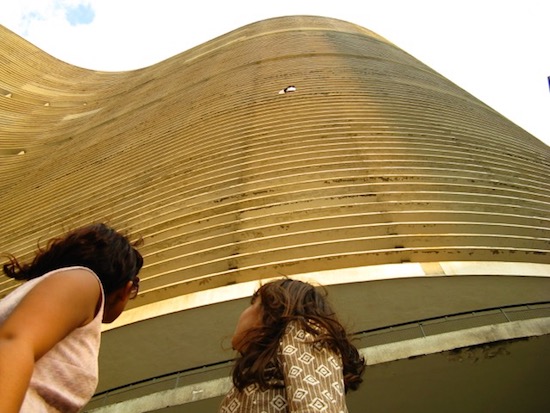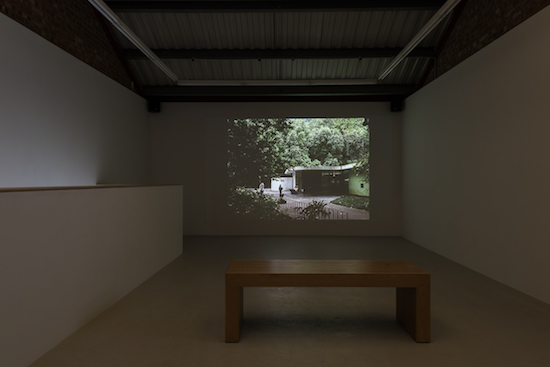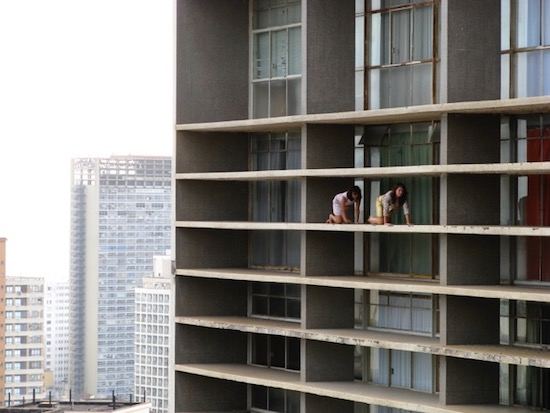We are twenty-two floors up the Edifício Copan, a 118.44-metre tall residential building in downtown São Paulo, one of the largest in Brazil. The sun is bright, bleaching the sky in washed-out colours. There is a slight breeze. The camera is still.
Two young women – the artists Michelle Williams Gamaker and Julia Kouneski – crawl, on their hands and knees, slowly and carefully, along the window ledge of the Copan’s famously undulatory exterior. The ledge can scarcely be more than a few feet wide. Their journey, from end to end, there and back again, lasts eleven and a half minutes. “The action,” Kouneski tells me, when I ask how it felt up there, “required us to be absolutely present in that moment, putting one hand, and one knee after the other.”
Williams Gamaker agrees. “Personally, it cannot be compared to any experience I have had,” she says. “Every muscle was tense, because in hindsight every moment that we crawled along the ledge was an act of survival.”
Just watching the film, projected onto the far wall of Annka Kultys’s gallery in Bethnal Green, is a terrifying, vertiginous experience. I could feel my own muscles tense up in sympathy with each forward pace the two artists take. Despite its rather more Béla Tarr-esque shot length, Scaling Copan(2009) has all the drama, all the suspense and high-wire jitters, of a Hitchcock thriller.
But, like all good thrillers, it also has its moment of levity and relief. About half-way through the film, its two director-stars reach their destination – the far end of the building – and they pause, take a seat, and start to playfully swing their legs over the ledge, close to a hundred metres up, above the streets of São Paulo. It’s a delightful moment. For just those few brief seconds, they both seem so free. “As we sat,” Williams Gamaker tells me, “at the end of the ledge, I remember the elation, the adrenalin rush, the thrill of looking at the city, the urban sprawl.” It becomes a lesson in finding moments of joy in even the most precarious of situations.
Williams Gamaker and Kouneski had both come to Brazil in search of Lygia Clark. The Bela Horizonte-born Neo-Concretist had been dead since 1988. But, each fascinated by her late work in which Clark’s focus had shifted, as Williams Gamaker puts it to me, “from painting and sculpture to experiential / participatory work”, they had both crossed continents to seek out her traces, to speak with those who had worked with her and try to understand the landscape of the country that informed her practice. “I couldn’t research her work,” Williams Gamaker confirms, “without activating the research by feeling it, living it.”

“For me everything is connected,” Clark had once written in a letter to Hélio Oiticica. “The object no longer is there in order to express any concept whatsoever, but so that the spectator can reach, more deeply, his own self.” Born in 1920, by the mid-1960s Lygia Clark had abandoned the angular, constructivist style of painting for which she had been celebrated in the previous decade. Abandoned, too, were the sculptural ‘Bichos’ (Creatures) she had constructed in aluminium in the first few years of the 1960s. She turned, instead, to a softer, subtler, more relational aesthetic.
“Finally,” Mario Pedrosa had exclaimed of Clark’s Soft Works of 1964, “an artwork you can kick!” Made of rubber, spongily pliable, and appended with hand-written signs inviting spectators to “Please Touch” or “Handle”, the Soft Works were quietly subversive, upending in a stroke centuries of museological etiquette. Pedrosa, one of Brazil’s pre-eminent critics at the time, clearly recognised this, immediately. But they were only the beginning.
It was Pedrosa who, some years earlier, had introduced Clark and her fellow Neo-Concretists to the phenomenology of Maurice Merleau-Ponty, the psychoanalysis of Sigmund Freud. By 1964, Clark, in particular, was reading voraciously and widely. Her concerns drew closer to those of philosophers and psychiatrists, like Jacques Lacan and R.D. Laing, than most contemporary artists.
One of the first manifestations of these new concerns was the series of Objetos relacionais, the name already a nod to the theory of ‘transitional objects’ developed by British psychoanalyst Donald Winnicott. Her Air & Stone of 1966 consisted of just a small plastic bag, a rubber band, and a pebble. In order to experience the work, one didn’t simply look at it – or even merely touch it – it was necessary to fill the bag with your own breath, to seal it tight and place the pebble on its top, and then press it with your hands, feeling the semi-solid mass of one’s own breath as a tangible force between your fingers. Her Sensorial Hoods of 1967 had to be worn over the head, isolating the participant from the outside world and working on different senses individually by means of aromatic seeds around the nose or tiny mirrors in front of the eyes.
By the end of the 1970s, Clark had ceased creating and exhibiting objects altogether. Art had become for her a “field of being and events” or a “course of treatment”; the audience were no longer spectators, but “clients”. She would receive these clients three times a week at her apartment in Rio for sessions typically lasting one hour, inviting them to participate in what might be described as either a kind of immersive therapy or a single sprawling artwork, engaging the entire sensorium of the subject, body and soul, and bearing the title Structuring the Self.
In an essay written for the New York Museum of Modern Art’s 2014 exhibition Lygia Clark: The Abandonment of Art, Christine Macel describes something of the experience of this final work of the Brazilian artist:
“Clients were invited to lie down on the Grande colchão (Large mattress) full of styrofoam balls. Clark used various objects, such as stones placed on different parts of the body, or fabrics, from veils to blankets; she also offered cushions filled with heavier or lighter objects, objects made from stockings containing different materials (balls, stones, shells), and plastic bags filled with air, water, or sand. Some were the product of her earlier experiments with sensory objects, like Respire comigo. Others, such as a long cardboard tube, had been used in acts at the Sorbonne – in this case Relaxação, a collective act from 1974-75 similar to the therapeutic protocol. Heavy or light, quiet or noisy, hot or cold, the object moved over the client’s body, was used or even destroyed, like a plastic bag she suggested they pop – or not. Some objects, like honey, could even be incorporated into the body. A stone held in the palm of the hand served as proof of reality.”
One of Clark’s clients at this time was the singer-songwriter Jards Macalé, a key member of the Tropicalia movement who had worked extensively with Maria Bethania, Gal Costa, and Caetano Veloso. Macalé would later recall Clark’s words to him: “Whenever you feel empty, don’t fight against the void. Don’t fight against anything. Let yourself remain empty. Little by little you’ll be filled until you get back to the normal state of the human being, which is the creative.” The story of Macalé’s breakdown and subsequent recovery amidst the soft folds of Clark’s installation is told by one of the party guests glimpsed in another film, shown alongside Gamaker and Kouneski’s Scaling Copan at Annka Kultys, called Canoas.

Canoas is the work of another Bela Horizonte-born artist, Tamar Guimarães. Shot on 16mm and lasting a little over 13 minutes, Guimarães’s film depicts a party taking place in the former residence of architect Oscar Neimeyer. As members of Brazil’s cultural and social elite drink, dance, and discuss cultural history (including the story of Macalé’s encounter with Structuring the Self), Guimarães’s camera focuses on the otherwise-ignored servants who move silently through the house, catering to the needs (or whims) of the guests. “Canoas was made for a Biennial at a point when economic growth turned to euphoria about the future. In 2010 there was an incredible mood of optimism in Brazil,” Guimarães states in an interview with Pablo León de la Barra. “I wanted to produce an echo chamber in which to bounce the developmental euphoria of the 1950s – when the then president Juscelino Kubitscheck spoke of ‘50 years in 5’ – onto what were our contemporary stakes.” There is, of course, another layer of irony here that Guimarães leaves unstated. That Kubitscheck’s five-year presidency, from 1956 to 1961 – during which Niemeyer was able to build not just his own residence where Canoas was filmed, but also the extraordinary, futuristic new capital of Brasilia, and the São Paulo housing estate, Edifício Copan – were nonetheless succeeded, within just a few short years, by a brutal military dictatorship.
“The Copan Building in a sense becomes a relational object in Scaling Copan,” Kouneski tells me. “Instead of placing the relational object on us, we are placing ourselves on or within the architecture of the Copan Buliding, intentionally working with the sensations this action produces.”
Some weeks after my first visit to Annka Kultys Gallery to see Scaling Copan and Canoas, I find myself there again, watching Williams Gamaker and Kouneski perform with a group of four students from Goldsmiths. Intended as a response, both to their own film of some years earlier and to Guimarães’s staged cocktail party, the performance finds all six performers in vintage cocktail dresses, a little like those Guimarães imagines Niemeyer and his friends might have worn at any of the many parties held at his home in the 1960s. The group sits, for the most part on the floor, breathing into clear plastic bags and pressing the resulting pillows against each other’s bodies.
“The performances are still very new,” Gamaker tells me, “they were also about live experimentation. They relate strongly to Clark’s works with breathing at the core, for example Respire Comigo (Breathe with me) and the casing, wrapping, and enveloping of the body in her Structuring of the Self therapeutic work. We felt that our ‘breathing propositions’ were very much about sharing and exchanging. The breath as a kind of ‘life experience’ shared between others. There was something deeply intimate about the exchange. At moments tender, at times more vampiric.”
There is something playful, deeply tender about the performance. But something else, too. A hint, perhaps, of the slightly unsettling, even somewhat cult-like aspect of Clark’s work. A certain darkness at the edge of the frame. At one point, Williams Gamaker herself sits inside a very large plastic bag which all five other performers participants gradually fill with their own breath. It’s a sensuous commingling, a moment of coming together through the sharing of breath – but also, of course, highly dangerous, bearing always, inextricably, the threat of death by suffocation. This “vampiric” element that Williams Gamaker mentions to me. “The breath into the plastic bag,” as Kouneski says, “as life but also something potentially toxic.”
Michelle Williams Gamaker’s video installation with Mieke Bal, Madame B. Explorations in Emotional Capitalism, is at Ars Nova, Turku, Finland, until 28 May


